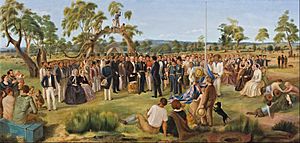Proclamation Day facts for kids
Proclamation Day is a special day that celebrates the start of government in the province of South Australia. It's celebrated every year on December 28th in South Australia, even though it's no longer a public holiday. In the past, Western Australia also had a Proclamation Day on October 21st, marking when it became self-governing.
Contents
South Australia's Proclamation Day
How South Australia Began
Proclamation Day in South Australia celebrates when the British government officially set up a new area called South Australia. The British Parliament created South Australia as a British province in 1834. This law allowed King William IV to start the colony and its government.
The King made it official on February 19, 1836, with a special document called Letters Patent. The big announcement about the new government happened on December 28, 1836. Captain John Hindmarsh, the first Governor, read the proclamation. He did this next to The Old Gum Tree in what is now Glenelg North. The proclamation said that local Aboriginal people would have the same legal protection as the new settlers.
The First Printing Press
The proclamation was written on board the ship Buffalo by George Stevenson, Governor Hindmarsh's secretary. It was then printed by Robert Thomas. Robert Thomas came from England with his family on the ship Africaine. They arrived at Holdfast Bay on November 8, 1836.
Robert Thomas brought the very first printing press to South Australia. This press was a Stanhope Invenit No. 200. It was on display at the State Library for many years. Robert Gouger, the Colonial Secretary, who also traveled on the Africaine, signed the proclamation.
The First Ships Arrive
Before Governor Hindmarsh arrived on the Buffalo, eight other ships came to the colony. These ships, known as the colonising fleet, first reached Nepean Bay on Kangaroo Island. They were then told to go to Holdfast Bay on the mainland.
The Duke of York was the first ship to arrive at Nepean Bay on July 27, 1836. The Africaine was the seventh ship, arriving on November 4, 1836. It dropped off settlers at Holdfast Bay on November 9, 1836. These earlier ships helped prepare the area before Governor Hindmarsh's official arrival on December 28.
Robert Thomas's wife, Mary, wrote a diary about their journey. She described their early years in South Australia. She wrote that around December 20, 1836, they built a small hut. In this hut, the first printing in South Australia took place.
What the Proclamation Said
The proclamation was a very important message from Governor John Hindmarsh. Here's what it said:
By His Excellency John Hindmarsh, Knight of the Royal Hanoverian Guelphic Order, Governor and Commander-in-Chief of His Majesty’s Province of South Australia.
I am telling the people settling in South Australia that the government has started. I ask you all to behave well and peacefully. Please respect the laws. By working hard and living soberly, by being good people and following religious rules, you will show you are worthy founders of a great and free colony.
It is also my duty to tell you that I will use all legal ways to protect the Native Population. They will have the same protection as all other subjects of the King. I am determined to punish very strictly any violence or unfairness against the Natives. They are just as much under the law's protection as the settlers. They also have the same rights as British subjects. I trust that everyone will be fair and patient when dealing with the Native Inhabitants. I hope you will help me carry out the King's kind and good plans for them. This means helping them become more civilized and, with God's help, eventually become Christians.
By His Excellency’s Command,
God Save the King.
Robert Gouger,
Colonial Secretary.
Glenelg, 28th December 1836.
Proclamation Day as a Holiday
In 1876, the government decided to move the Proclamation Day holiday. It was usually on December 28th. They wanted to move it to December 27th to create a three-day Christmas holiday weekend. Many people, like Henry J. Moseley, who owned the Pier Hotel in Glenelg, protested this change. Because of the protests, the holiday was moved back to December 28th.
Proclamation Day became an official public holiday because of a law called the Holidays Act, 1910. Originally, if December 28th fell on a Saturday or Sunday, the holiday was celebrated on the following Monday.
However, on November 4, 1993, the law was changed. Proclamation Day was moved to the day after Christmas Day. This means it now happens on the same day as Boxing Day in other parts of Australia. This change was made to help businesses, especially shops, avoid stop-start work patterns. It also helped make public holidays more similar across the country.
Even though it's no longer a unique public holiday, formal ceremonies still happen. Important officials and politicians attend these events at the Old Gum Tree in Glenelg North. Public celebrations often follow. These events usually take place on December 28th, or sometimes on December 27th. However, a small survey in 2015 showed that many South Australians didn't know why Proclamation Day was celebrated. It was also not part of the school curriculum.
Western Australia's Proclamation Day
Proclamation Day also refers to October 21, 1890, in Western Australia. This was the day Western Australia gained self-government. This meant it got its own constitution and its own elected parliament.
Proclamation Day was once a public holiday in Western Australia. But its importance was soon overshadowed by celebrations for the Eight Hours Day, which happened on the same date. By 1919, Proclamation Day was no longer a public holiday and was replaced by Labour Day.
Today, Western Australia Day is celebrated on the first Monday in June each year. This day remembers the founding of the Swan River Colony in 1829.


